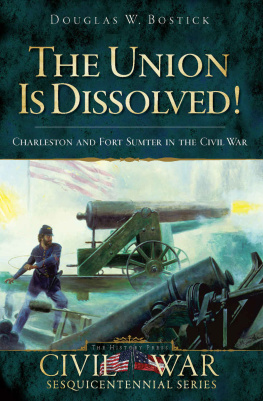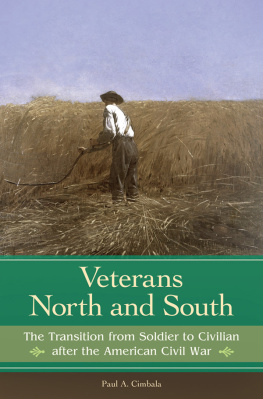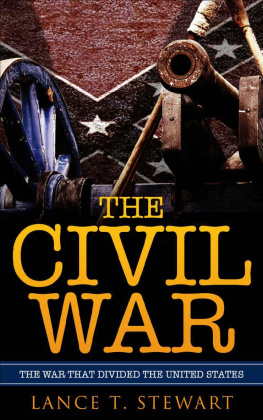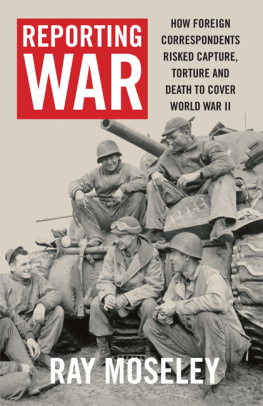The Words of War
By
Donagh Bracken

Copyright 2007 by Donagh Bracken
All rights reserved. No part of this publication may be reproduced, stored in a retrieval system, or transmitted in any form or by any meanselectronic, mechanical, photocopying, recording, or otherwisewithout prior written permission from Donagh Bracken.
Published in the United States by
History Publishing Company, LLC
Palisades, New York
Publishers Cataloging-in-Publication
Bracken, Donagh
The Words of War/
by Donagh Bracken.
p.cm.
Includes bibliographical references and index.
LCCN 2006938438
ISBN-13: 978-1-933909-32-5
ISBN-10-1-933909-32-3
1.United StatesHistoryCivil War, 1861-1865 Press coverage. 2.United StatesHistoryCivil War, 1861-1865Campaigns. 3.United StatesHistoryCivil War, 1861-1865Journalists. 4.JournalismNew York (State)New YorkHistory19th century. 5.Journalism South CarolinaCharlestonHistory19th century. 6.American newspapersNew York (State)New YorkHistory 19th century. 7.American newspapersSouth Carolina CharlestonHistory19th century. I Title.
E609.B733.2007 973.7
QBI06-600707
Printed in the United States on acid-free paper
9 8 7 6 5 4 3 2 1
First Edition
Contents
CHAPTER 1:
Fort Sumpter
CHAPTER 2:
First Manassas
CHAPTER 3:
Fort Donelson
CHAPTER 4:
Hampton Roads
CHAPTER 5:
Shiloh
CHAPTER 6:
Williamsburg
CHAPTER 7:
Second Manassas
CHAPTER 8:
Antietam
CHAPTER 9:
Fredricksburg
CHAPTER 10:
Gettysburg
CHAPTER 11:
Vicksburg
CHAPTER 12:
The Wilderness
CHAPTER 13:
Cold Harbor
CHAPTER 14:
Petersburg
CHAPTER 15:
Atlanta
CHAPTER 16:
Opequon
CHAPTER 17:
A Casualty of War
CHAPTER 18:
Appomattox Court House
Acknowledgments
In order to properly acknowledge all those who contributed to this book, it is necessary to reach back fifteen decades to those in American journalism whose work is contained on these pages. There are men whose contributions, unfortunately, are anonymous at this point: the newspaper compositors and the telegraph operators and all the others on the technical end who made the Charleston Mercury and The New York Times possible. Then there are the names we remember: Henry J. Raymond and Robert Barnwell Rhett, whose identities with The New York Times and the Charleston Mercury will forever be linked. So, too, the gentlemen whose writings made newspaper history: Franc Wilkie, L.L. Crounse, Sam Wilkeson, and William Swinton, all of the Times, and George William Bagby who wrote under the pen name, Hermes, for the Mercury, and Robert Barnwell Rhett, Jr., the actual editor of the Mercury, who toiled in relative obscurity in his fathers shadow.
To those with us today who put the battles contained herein into historical perspective, much is owed. In 1993, the Civil War Sites Advisory Commission brought together prominent civil war historians for their knowledge, input, and analysis of civil war battles. The resulting summaries provided a more clear understanding of each battle, qualities that might not have been so evident to the early war correspondents.
Many thanks are due to Beatrice Agnew, Marie Firestone, and the staff of the Palisades Free Library, in Palisades, New York. For their reach into the inter-library loan system on my behalf, a special acknowledgment goes to Joanna Lo and Mary Beth Darnobid of the reference desk. My appreciation goes also to Dr. Libby Chenault and Gary Patillo of the University of North Carolinas Wilson Library and Davis Library, respectively, and Tom Nix of the reference staff of that great university. Thanks, too, to Katie Gray of the Charleston County Public Library in Charleston, South Carolina, and Susanne Christof and Elaine McConnell of the Special Collections Section, and Nick Battipaglia of the Reference Section of the United States Military Academy at West Point.
And to those who took my compilation of information and turned it into the attractive book it is, I am very much indebted: Tom Cameron, Senior Editor of History Publishing Company, whose artistic typographical touch and editorial skills are superbly demonstrated, and whose insightful suggestions brought a bright polish to areas in need of a glow; Ann Walter for her tireless eye and interesting thoughts on the English language of the Civil War era; and Blair Sutphen who designed the eye-catching cover graphic that captured everything in the book. A note of thanks, as well, to Marcia Carlson, who compiled a thorough index of a rather complicated subject.
And, of course, to my sons Chuck and Don and daughter-in-law Elizabeth, whose interest in my progress never wavered, goes my deep appreciation. To my special friend, June Starke, whose carefully phrased questions relating to the progress of the book were really more prod than query, I owe a heartfelt sense of gratitude.
Introduction
A Note to the Reader About Newspaper Style During the Civil War
When the Charleston Mercury and The New York Times reported on the Civil War, they captured the fever of that great war and the flavor of the era. The language used by both newspapers was influenced by their European counterparts, the London Times specifically, which was then the preeminent newspaper.
Of particular note is that the articles reproduced here are original, unaltered, battlefield reports as sent from the nearest telegraph station. They include all the typos, convoluted syntax, stylistic peculiarities of the era, and perhaps inaccuracies one might expect from inexperienced and rightfully frightened reporters. The reports, as written, were immediately sent to press, without review or editing.
Dispatches from correspondents like Franc Wilkie, in the West, and L.L. Crounse and William Swinton, in the East, were printed verbatim. Telegraph companies charged by the word. To save costs, reporters would join two words into one. So Lees Army became Leearmy, and, when it came to stating the time of action, just 12 o would suffice because everyone knew the next word should be clock.
There is one other jounnalistic aspect to this book, the war artist. The technology of photography was too cumbersome to capture the actual battle scenes. Because of the daily nature of the newspaper, illustrations in the newspapers were limited to rough line drawings of maps and diagrams of the war. Often they showed unfamiliar terrain with unfamiliar names. But there were periodicals other than newspapers, the weekly journals, Harpers Weekly and Frank Leslies Illustrated Magazine, that dispatched artists such as Edwin Forbes, the brothers William and Alfred Waud, and Theodore Davis to sketch events as they happened. These drawings would then be sent to the magazines and turned into line engravings. In company with the correspondents writings of the Times and Mercury, some of the artists renditions are presented, many with the artists notes snapshots of events as they occurred.
When the Civil War started, American journalism was put to the test. It was the start of the modern age of journalism, and it was a rough start indeed. Newspapers had to wrest themselves from an unsavory past with propagandistic objectives to the dissemination of information relatively free of propaganda. In this objective they were not entirely successful; but in the restructuring of their nature, they did achieve lasting success.






